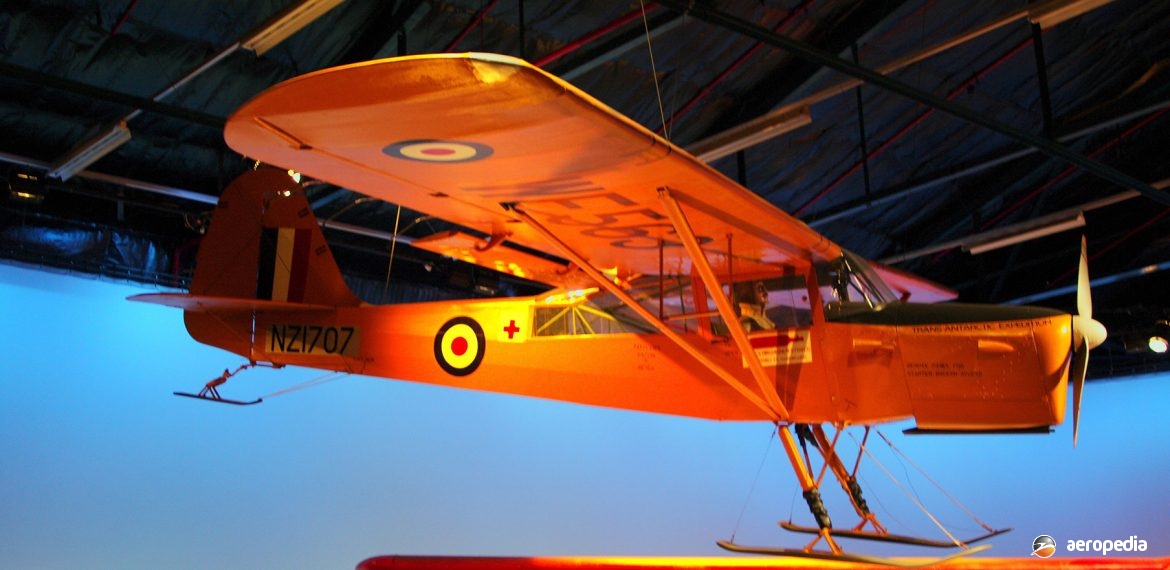Photograph:
Auster AOP-7c Antarctic NZ1707 at the RNZAF Museum at Wigram, NZ in 2013 (Steve Veigel)
Country of origin:
United Kingdom
Description:
Two-seat air-observation-post aircraft monoplane
Power Plant:
One 108 kw (145 hp) de Havilland Gipsy Major 7 four-cylinder in-line air-cooled engine
Specifications:
- Wingspan: 11 m (36 ft)
- Length: 7.2 m (23 ft 9 in)
- Height: 2.6 m (8 ft 4½ in)
- Wing area: 17.4 m² (187 sq ft)
- Max speed at 305 m (1,000 ft): 200 km/h (124 mph)
- Cruising speed: 174 km/h (108 mph)
- Initial rate of climb: 247 m/min (810 ft/min)
- Service ceiling: 4,267 m (14,000 ft)
- Empty weight: 641 kg (1,413 lb)
- Loaded weight: 980 kg (2,160 lb)
History:
Following the cessation of hostilities in World War II, the Auster company decided to develop the AOP-6 air-observation-post aircraft for postwar use by the RAF. This involved strengthening the rear fuselage, increasing the maximum take-off weight, installing the de Havilland Gipsy Major 7 engine in place of the Lycoming, lengthening the undercarriage legs, and increasing fuel capacity.
The prototype AOP-6 flew for the first time on 1 May 1945, and subsequently 312 examples were delivered to the RAF, with the last aircraft being delivered in March 1953. Others were supplied to Iraq, Jordan, Belgium, Rhodesia.
Two (serials A11-200 and A11-201) were delivered to the Australian National Antarctic Expedition (ANARE). Obtained in 1953 they had previously seen service with the 1949-1952 Norwegian-British-Swedish Antarctic Expedition. They were obtained to carry out operations from Mawson Station during the 1954 expedition to Mac-Robertson Land. However, during the voyage south on the ‘Kista Dan’ they were both damaged during a storm so one aircraft was built from the two airframes, becoming A11-201.
There were further problems when A11-201 was badly damaged when it was lost overboard during a hurricane. The airframe was again recovered and rebuilt by the Royal Victorian Aero Club, seeing service with the ANARE for reconnaissance, photography and field support during the 1955-1959 expedition. Later, after retirement from RAAF service, it became VH-RCT (c/n 1364). It was finally written off when it crashed at Cape Barren Island, TAS, in February 1964.
The AOP-6 could be fitted with floats and skis as well as the normal wheeled undercarriage. A two-seat training version of the AOP-6 was also offered and purchased by a number of countries. Known as the Auster T-7, it varied mainly in having dual controls.
One Auster T Mk 7c was obtained by the RNZAF. After service with the RAF (WE563) as a reserve aircraft for the British Antarctic Expedition in the early 1950s, it was obtained on 28 May 1956 and became NZ1707, being obtained to provide support for the Commonwealth Antarctic Expedition of 1957-1958. It first flew in New Zealand on 7 August 1956 and was fitted with wheels, skis later being attached inthat month. It overturned on the Tasman Glacier during a training exercise on 19 August 1956 and was repaired on site. It was shipped to the Antarctic on board ‘HMNZS Endeavour’ in December 1956 and was fitted with floats.
On arrival it was flown on 29 January 1957. It operated alongside a de Havilland DHC-2 Beaver, returning to New Zealand in early 1958, serving in the army co-operation role until it crashed in Kaipara Harbour on 22 August 1966. It was recovered to Hobsonville by RNZAF Iroquois and was written off. After restoration by trainees at No 1 TTS it was subsequently presented to the Museum of Transport and Technology (MOTAT) in Auckland. It was later exchanged with the RNZAF Museum for an Auster J-1B ZK-BWH (c/n 3103) and has been placed on display at the museum at Wigram.
In 1970 an AOP-6 G-AVYU (c/n B.3746) was imported to Australia from the United Kingdom [in some references it has been referred to as a Beagle Terrier I] and has since been restored in Victoria, becoming VH-BGL in 1999. In early 2016 a Mk 6 arrived at Camden, NSW for an Australian owner, this aircraft C-FLOE (c/n TAY297V) being imported from Nipawin, Saskatchewan in Canada , being powered by a de Havilland Gipsy Major 7 engine. However, it required considerable restoration work which had not been completed by early 2020.
Other aircraft have been imported for restoration, including Auster T-7 WE552 at Christchurch, NZ which previously operated as HKG-4 in Hong Kong and VF643, an AOP-6, which also operated in Hong Kong as HKG-5.

